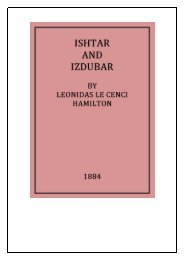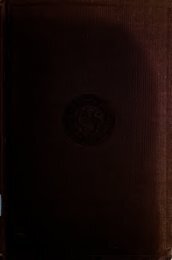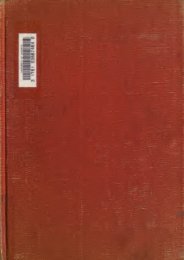The great cylinder inscriptions A [and] B of Gudea, copied from the original clay cylinders of the Telloh Collection Vol. 1 by I. M. Price (1899)
You also want an ePaper? Increase the reach of your titles
YUMPU automatically turns print PDFs into web optimized ePapers that Google loves.
IV<br />
picture, on p. VI. taken b}- <strong>the</strong> author while in <strong>the</strong> midst <strong>of</strong> his work. Cylinder A is<br />
on <strong>the</strong> left, <strong>and</strong> Cylinder B occupies <strong>the</strong> right end <strong>of</strong> <strong>the</strong> case). <strong>The</strong> first difficult}', during<br />
more than forty days, or 200 hours, <strong>of</strong> close work, gradually wore awa\-. But <strong>the</strong> second<br />
was a continual menace to <strong>the</strong> eyes, especially when obliged to use a magnifying glass,<br />
requiring at <strong>the</strong> same time an especial effort to overcome <strong>the</strong> glare caused <strong>by</strong> <strong>the</strong> two surfaces<br />
<strong>of</strong> glass.<br />
Cylinder A is a hollow <strong>clay</strong> <strong>cylinder</strong>. 61 centimeters in length <strong>and</strong> ^2 cent, in diameter,<br />
<strong>the</strong> rim <strong>of</strong> <strong>clay</strong> being about two cent, thick. Although this <strong>cylinder</strong> had been<br />
broken into pieces, <strong>the</strong>se pieces have been ga<strong>the</strong>red up <strong>and</strong> nicely adjusted, with <strong>the</strong> loss<br />
<strong>of</strong> but a few fragments. <strong>The</strong> surface is quite well preserved, aside <strong>from</strong> a few places unfortunately<br />
rubbed, <strong>and</strong> o<strong>the</strong>rs covered with a semi-transparent hard deposit. <strong>The</strong>se places were<br />
read, where read at all, only with difficulty.' Some assistance was secured <strong>by</strong> <strong>the</strong> use <strong>of</strong><br />
a mirror, casting upon <strong>the</strong> doubtful portion a strong ray <strong>of</strong> sunlight, <strong>and</strong> <strong>the</strong>n magnifying<br />
such special place. Cylinder A carries thirty columns, averaging about eighty lines (not<br />
cases) to <strong>the</strong> column. <strong>The</strong> first-half <strong>of</strong> <strong>the</strong> inscription is more compactly <strong>and</strong> solidly written<br />
than <strong>the</strong> latter part; <strong>the</strong> scribe apparently discovered that he was not obliged to crowd his<br />
matter to find room for all <strong>of</strong> it on <strong>the</strong> <strong>cylinder</strong>, <strong>and</strong> <strong>the</strong>reafter wrote more loosely.<br />
Cylinder B is also a hollow cla\- <strong>cylinder</strong>, 56 cent, in length, <strong>and</strong> 33 cent, in diameter,<br />
<strong>the</strong> rim <strong>of</strong> <strong>clay</strong> being about two cent, thick. It contained <strong>original</strong>ly twenty-four<br />
columns, averaging about sixty lines to <strong>the</strong> column. With a less number <strong>of</strong> columns <strong>and</strong> a<br />
le.ss number <strong>of</strong> lines to <strong>the</strong> column, <strong>and</strong> a slightly larger diameter than Cylinder A, <strong>the</strong> signcharacters<br />
are larger <strong>and</strong> <strong>the</strong> whole inscription is more loosely written than Cylinder A.<br />
This <strong>cylinder</strong> also had been broken into pieces, but has been carefully readjusted. Unfortunately<br />
nearly all <strong>of</strong> <strong>the</strong> last quarter <strong>of</strong> it is lost, toge<strong>the</strong>r with small pieces here <strong>and</strong> <strong>the</strong>re<br />
in <strong>the</strong> body <strong>of</strong> <strong>the</strong> inscription. A few portions, too, have been damaged <strong>by</strong> a hard deposit,<br />
but <strong>the</strong> size <strong>of</strong> <strong>the</strong> signs is more <strong>of</strong> an aid to <strong>the</strong> decipherer than those on Cylinder A.<br />
Cylinders A <strong>and</strong> B toge<strong>the</strong>r, in <strong>the</strong>ir present form, carry more than 10,600 characters,<br />
<strong>and</strong>, as will be seen <strong>by</strong> <strong>the</strong> Sign-List (pp. 89 — 11 1), more than 325 different signs, — many<br />
<strong>of</strong> <strong>the</strong>m peculiar to <strong>the</strong>se c_\-linders.<br />
In <strong>the</strong> revision <strong>of</strong> his first readings <strong>the</strong> author had <strong>the</strong> valuable assistance <strong>of</strong> <strong>the</strong><br />
e.xpert Assyriologist <strong>and</strong> attache <strong>of</strong> <strong>the</strong> Louvre, M. Frangois Thureau-Dangin. His skilled eye<br />
rendered especial aid in <strong>the</strong> reading <strong>of</strong> <strong>the</strong> earlier parts <strong>of</strong> cols. X, XI, <strong>and</strong> XII <strong>of</strong> C}'linder<br />
A, <strong>and</strong> in <strong>the</strong> damaged <strong>and</strong> partially deposit-covered portions <strong>of</strong> cols. IV <strong>and</strong> \'II <strong>of</strong><br />
Cylinder B, as well as in <strong>the</strong> depiction here <strong>and</strong> <strong>the</strong>re <strong>of</strong> individual signs.<br />
In <strong>the</strong> autographic work, <strong>the</strong> author has endeavored to transmit to paper as nearly<br />
as possible, both <strong>the</strong> size <strong>of</strong> <strong>the</strong> column <strong>and</strong> <strong>the</strong> form <strong>of</strong> <strong>the</strong> sign, contained on <strong>the</strong> <strong>original</strong><br />
<strong>clay</strong>, — even to some apparent mistakes <strong>of</strong> <strong>the</strong> scribe, for example, in Cylinder A,<br />
IV, 9, /(?;-, in 12, ;/, etc. <strong>The</strong> variations in <strong>the</strong> number <strong>of</strong> wedges in many signs reveal <strong>the</strong><br />
fact that considerable liberty was allowed in <strong>the</strong> formation <strong>of</strong> <strong>the</strong> characters (see Sign-List<br />
for variations). <strong>The</strong> author's reproduction <strong>of</strong> na in Cylinder A should have, at <strong>the</strong> right<br />
end <strong>of</strong> <strong>the</strong> horizontal line, as it has in Cylinder B, but one instead tivo wedge-heads.<br />
<strong>The</strong> author, too, has labored under <strong>the</strong> disadvantage <strong>of</strong> being absent <strong>from</strong> <strong>the</strong><br />
<strong>original</strong>s in his autographic work. This may result, on fur<strong>the</strong>r investigation, in discovering<br />
some erroneous readings. But he ventures to hope that <strong>the</strong>se may be so few as not to invalidate<br />
<strong>the</strong> <strong>great</strong> body <strong>of</strong> <strong>the</strong> <strong>inscriptions</strong>.<br />
Several questions <strong>of</strong> vital importance in cuneiform research have been suggested<br />
in connection with <strong>the</strong> stnd\- <strong>of</strong> <strong>the</strong>se <strong>and</strong> o<strong>the</strong>r (nulean <strong>inscriptions</strong>: (I) <strong>The</strong> direction <strong>of</strong>


![The great cylinder inscriptions A [and] B of Gudea, copied from the original clay cylinders of the Telloh Collection Vol. 1 by I. M. Price (1899)](https://img.yumpu.com/56829439/8/500x640/the-great-cylinder-inscriptions-a-and-b-of-gudea-copied-from-the-original-clay-cylinders-of-the-telloh-collection-vol-1-by-i-m-price-1899.jpg)





